|
|
 |
|
Il Quirinale |
|
written
by eatonj / 10.06.2004 |
|
|
|
|
|
| <click to type page headline> <use TAB to move to next textbox> |
1 of 1 |
|
| |
The social characteristics of the residents |
| |
| |
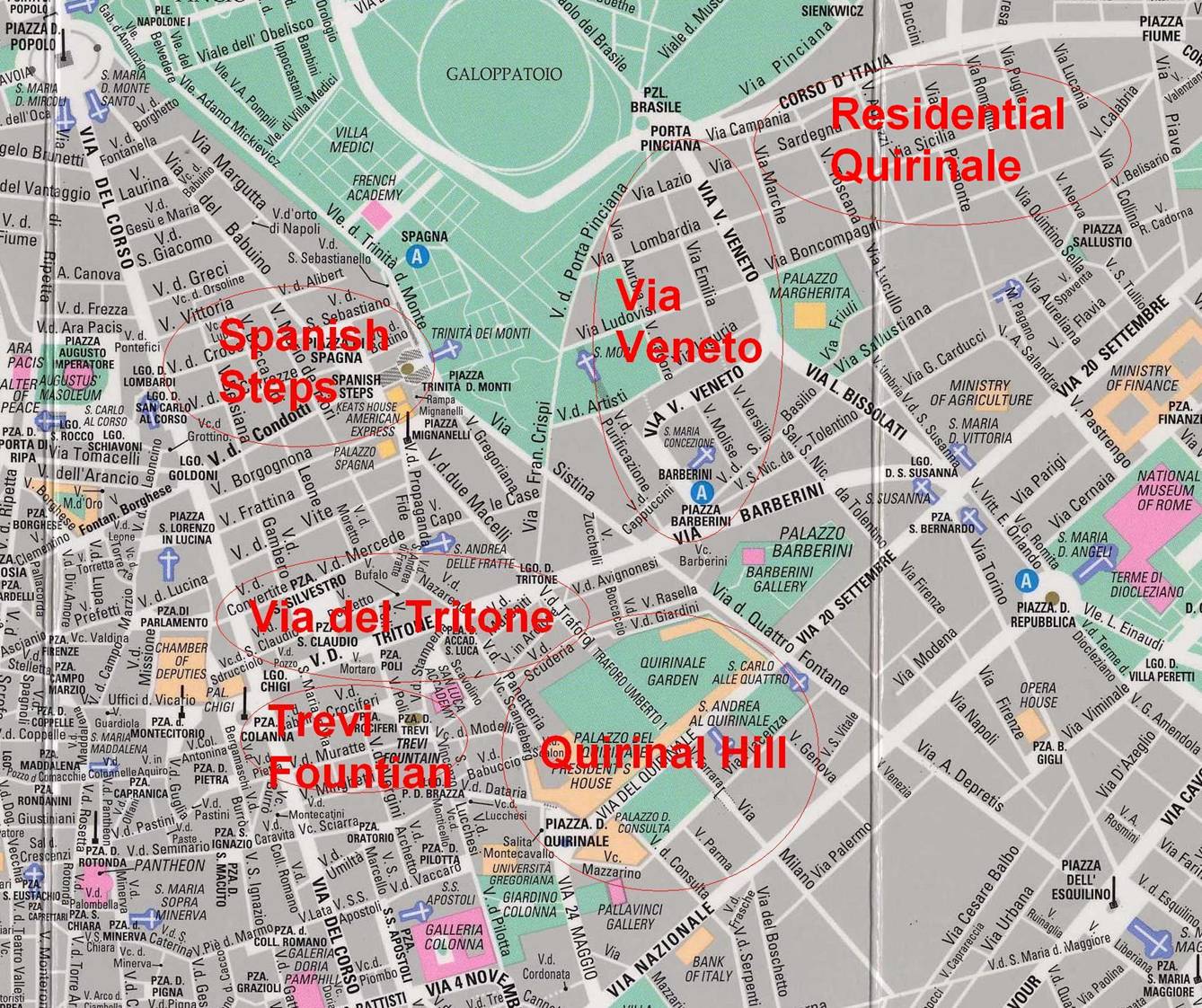
|
| Artwise map of Rome |
| Map of the Quirinale |
| A map of the Quirinale region with our six areas outlined |
| |
|
| |
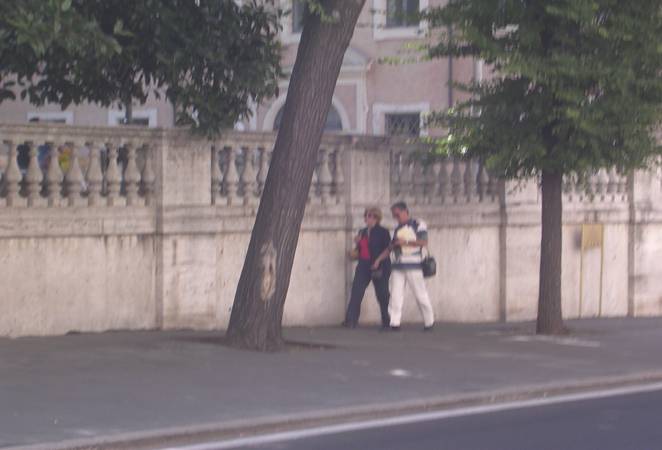
|
| Photo by Jeff Eaton |
| Tourists on the Quirinal Hill |
| There were only a few scattered tourists around the piazza and in the gardens on the top of the hill, no large tour groups or masses |
| |
|
| |
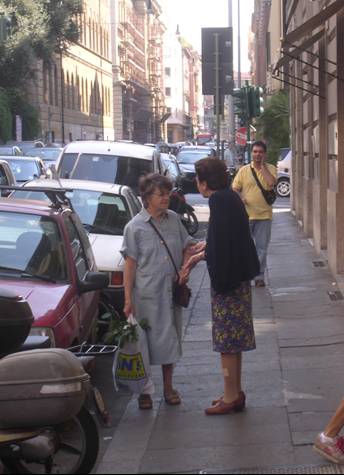
|
| Photo by Jeff Eaton |
| Ladies on the Sidewalk |
| Residential Quirinale was the only part of the neighborhood where we saw plainly dressed Italians going about daily business |
| |
|
| |
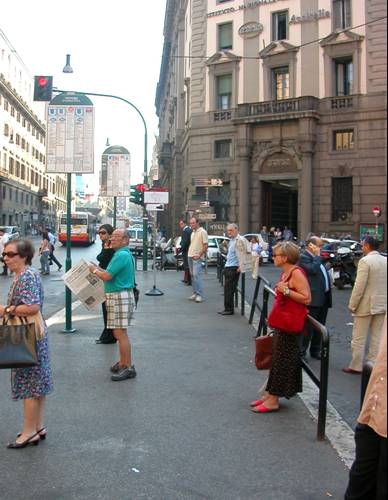
|
| Photo by Jeff Eaton |
| Waiting at the Bus Stop |
| Different strata of people mix at a bus stop on Via Tritone |
| |
|
| |
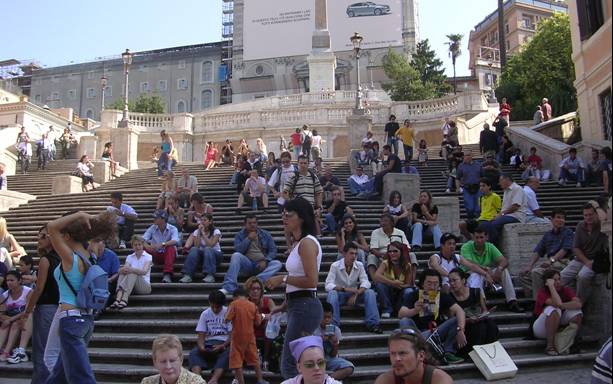
|
| Photo by Jeff Eaton |
| Tourists at the Steps |
| Many tourists congregate for a break on the Spanish Steps |
| |
|
| |

|
| Photo by Jeff Eaton |
| Tourists crowd around the Trevi |
| Huge masses of Tourists crowd around the Trevi Fountain for most of the day. These include both tourists on their own and large tour groups. |
| |
|
Quirinal Hill:
The primary resident of the Quirinal Hill is the president of Italy himself and his residence dominates the hill. While residents in the apartments around the top of the hill appeared to keep to themselves, and can only be viewed donning business suits on their way to work, however one can tell that these are mostly upper class, possibly government officials by the large clean apartments, clean streets, and nice cars and scooters parked along the streets. We were initially struck by the presence of new well-kept Mercedes Benzes, BMWs, Audis, and a Jaguar. As for other people on the hill, the security presence was high here; it was one of the only places in Rome where we have seen actual security guards standing, instead of just police guards. There was a much felt presence of not only Polizia and Cabinieri, but also armed military guards around the presidential palace and other government buildings.
Almost no civilians were to be found on the hill other than well-dressed men and a very few women riding Vespas on the way to work. In the parks across from the presidential palace sat a few young Italian couples (though it was not clear if they were residents of the Quirinale or not) and businessmen talking on cell phones, more likely there for their employment than residence. Tourists in small numbers, characterized by plain clothes, packs and maps were present in small numbers, especially along Via del Quirinale and in the Piazza del Quirinale, but the entire area was largely empty of pedestrians during both the morning and late afternoon when we visited. To generalize, the streets here are dominated by control: every one there “belonged” and there were no signs of social disorder to be found (homeless, gangs, loiterers, street vendors, stray animals, etc.)
Via Veneto:
The Via Veneto area contains very few actual residences, but many ritzy hotels (Westin, and similar quality) frequented by international diplomats, business men, and wealthy and typically senior tourists. On the streets there were well-dressed businessmen moving hastily about their duties or standing in small groups of two or three talking. Unlike the Quirinal Hill, however, one could see shop owners standing on the street, though they were more tidily dressed and kept than in other areas of the city. Also uniformed bell boys and restaurant waiters were moving around the sidewalks attending to their business. Once again outside government agencies and all around the US Embassy were posted security details and a police presence was felt along the sidewalks. Also important guests were indicated at the hotels by the presence of black tinted Mercedes with their chauffeurs clad in black suits.
In a sharp contrast to this, most of the patrons of the shops and restaurants along here were wealthy and older, most likely retired, tourists. Judging by language heard along the way and appearances, I would guess that most were American. Once again social control seems to be the name of the game along the streets, with no sidewalk vendors or homeless. There was however one striking exception to this. Outside the Italian Ministry of Labor building small but noisy group of six protesters dressed in black with painted signs hung between the post. There was a police guard in front of the ministry no more than a few yards from the group, but they appeared to carry on their protest without bother.
Residential Quirinale:
As by the label we gave to this area, it was largely residential. The residents appeared to be upper class by the cars and Vespas parked in the area, the clean decorated entranceways to apartments, and the nature and patrons of the nearby businesses. Inside the bars and markets were many wealthy looking Italians mostly of middle age in suits or skirts (guessing 40s), but there was also a notable group of young (late 20s/early 30s) Italians of the same class. This area of Quirinale was the only one in which casually dressed Italian citizens could be seen going about day to day activities. One could see small groups of ladies talking on the street. We did not get the impression, however, that this would be a place for families based on seeing no youths in the street and little to accommodate children, though this is hard to tell as we could not see inside the apartments.
There were absolutely no tourists here, no newsstands or snack stands, and no security, excluding a guard seen inside the door (but of note not outside) the door of a bank.
Via Tritone:
The people along Via Tritone were an interesting mix of commuters and tourists. Many Italians could be seen commuting to work dressed in both suits and more casual wear walking down the sidewalk or waiting for a bus. The tourists appeared to be middle-aged from a variety of countries. There were many more Western Europeans than in Veneto and most interestingly there seemed to be a good number of Italian families with children moving around with maps.
Security was much less present here. Shop owners were dressed more casually and there were newsstands and small “bibite” carts with, however there were still no peddlers with fake Prada spread out on blankets.
Spanish Steps:
This area is characterized by a large group of international tourists grouped around the steps. These tourists were much younger than those observed on Via Veneto, and appeared to be seeking (but not necessarily able to afford) a bit of the romantic glitz and glamour of Rome, with a walk around the steps and then a stroll through the high end designer retailers in the area. Along with the area could be found very rich Italian women of all ages (we saw both grandmothers and twenty year olds wearing Gucci) going about their shopping while their husbands presumably we had seen in their business suits in other parts of the upscale Quirinale.
There was a Polizia presence here, but instead of visible guards standing posts as around the governmental areas they were parked in their cars hidden away in the corners of the Piazzae.
Trevi Fountain:
There is no other way to describe this than tourist central. Hundreds of people of all ages and races could be found here sitting around the fountain or patronizing the tourist shops and inexpensive gelaterias and sandwich bars. The tourists were much more diversified in both economic class and ethnicity with many Asian, Eastern and Western European, and of course Americans. While tourists were found in many parts of Quirinale, this was the only one in which there were actual large groups of guided tours.
The few Italians that we did see were of lower class and more diverse racially, working in low level retail jobs in the shops. None were dressed in the formal business attire that distinguished the rest of Quirinale. Also along here were the African and Eastern vendors selling fake prada on blankets. Polizia presence was again found here in their cars parked in the shadows on side streets, but even more tucked away than in the Spanish Steps area.
|
| |
|
| |
|
| |
The distinctive economic and consumption activity in the neighborhood |
| |
| |
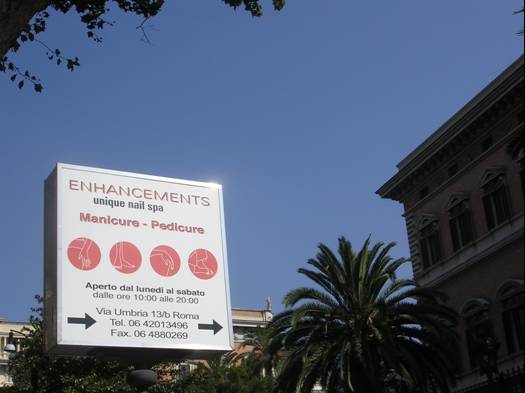
|
| Photo by Jeff Eaton |
| American Influence |
| Many signs such as this one along the Via Veneto were in English |
| |
|
| |
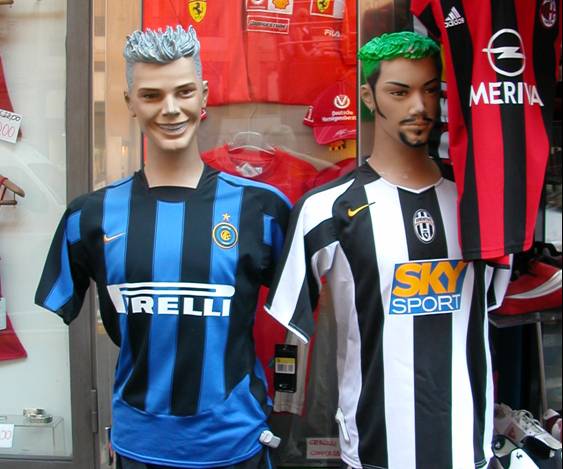
|
| Photo by Jeff Eaton |
| Manikins modeling jersies |
| Much of the economic activity along Via del Tritone was oriented towards a younger audience, such as these manikins modeling soccer jersies and Italy's trendiest hair styles |
| |
|
| |
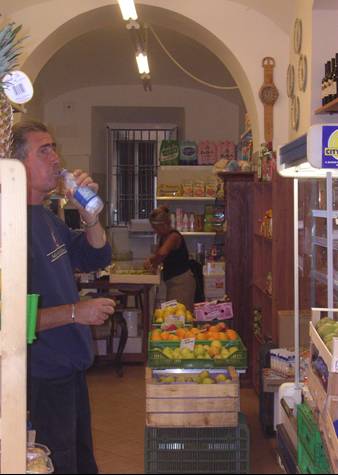
|
| Photo by Jeff Eaton |
| Grocery Store |
| A typical Italian grocery store found in the Residential Quirinale |
| |
|
| |
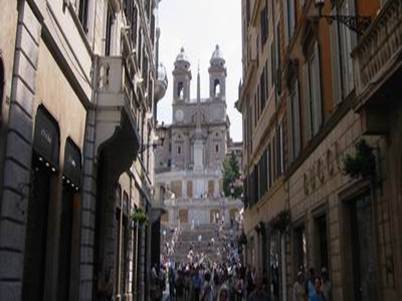
|
|
| Gucci Store |
| Gucci is only one of the designer retailers to be found on this street off the Spanish Steps. |
| |
|
| |
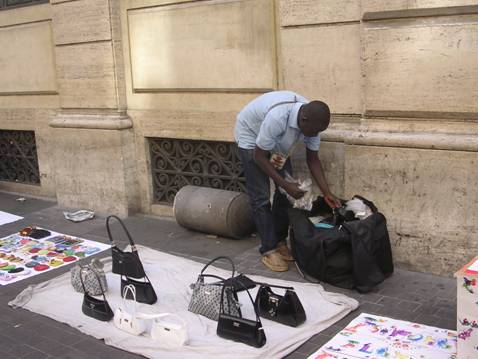
|
| Photo by Jeff Eaton |
| Tourist economic activity |
| For anyone willing to haggle a bit a good deal on a fake Prada was to be found around the Trevi Fountain |
| |
|
Quirinal Hill:
Quirinal Hill’s economic activity is organized around the ascension of the hill itself; one can see that the economic activity varies depending on how high one is on the hill. At the very bottom of the hill the economic activity is fairly typical of Rome, meaning that it is dotted by Tabbachi, Farmacia, small cafes and bars and an eclectic mix of small clothing and accessory shops. These seem to be catering to the average passerby who might need a bus ticket or be taken in by a 5 Euro shirt. The café prices are comparable to those in this area (i.e. 1 Euro cappuccino, 2 Euro sandwiches). One layer up, if you will allow the expression, the stores become slightly more refined: trendier clothing that costs about 50/60 Euro for pants, which is more than at the bottom of the hill without being designer wear. This area seems to cater to individuals in their early thirties, mostly business people. A couple of shops carried brand names like Diesel, but for the most part there weren’t any brand names to be seen. Notably, shopkeepers seem to speak better English in this area which suggests a fair amount of tourist shoppers. There are no Tabbachi in this area. As one continues up the hill, the shops begin to specialize in leather products and suit stores. It is clear that these stores are in existence solely because of higher class business men. As one gets towards the very top of the hill, there ceases to be restaurants and the only economic activity are high-end hotels which cater (most likely) to visiting politicians. Even these are few and far between. At the top of the hill there is no economic activity at all. In fact, there is no real street life to speak of. Specifically it seems that the entire summit of Quirinal Hill is dominated by politic buildings, the facades of which are decorated by Italian and European Union flags. There are none of the infamous, Italian street vendors anywhere on Quirinal Hill.
Via Veneto:
Via Veneto is home to the American Embassy. Most of the economic activity in the area was targeted towards diplomats, and politicians and their spouses and families, as well as wealthy American tourists. Extremely high-end clothing stores spotted the area, including places that featured 2000 Euro suits and 90 Euro ties, but for the most part this was not a shopping- mall-type street but rather oriented towards the high class, business man. There were a couple of book stores in the area (which suggest its proximity to the University and perhaps the education level of the inhabitants) but mostly it is extremely expensive restaurants and ritzy hotels that compose the streets. To give an idea of the prices in the area, a breakfast at the “D-ole-Y” (typical, trendy restaurant) was 42 Euro. A more “low-end” restaurant featured an “American breakfast” of eggs, bacon and yogurt for 13 Euro. We noted a Hard Rock Café and a Westin Hotel, which was more globalization than one typically finds in Roman neighborhoods. Notably, none of the classical Roman storefronts can be found in the area (Tabacchis etc). There seemed to be no small to medium, family-run enterprises or independent street vendors.
Residential Quirinale:
The economic activity in this area clearly characterized it as residential. There were small, family run groceries carrying meats and cheeses, as well as fresh produce. While prices here were higher than those in Campo di Fiori, they were comparable to average grocery prices in a store such as Punto SMA. There were also dry cleaners, hair salons, and petit, upscale coffee shops. No real shopping, but definite stores catering to every day necessities. Nonetheless, it was clear that shoppers in the area were wealthy as even the “day-to-day” goods and services were high-priced.
Via Tritone:
This economic sector blends into “lower” Quirinale Hill. That said, there were some minor distinctions. This particular street was economically oriented towards students with an inordinate number of news stands, small cafes, sportswear shops, and bookstores. Also, there were quite a few bookstores and music shops- which suggested student activity similar to the University area in Naples. It was clear that this area had a youth-oriented night life with ethnic food, piano bars and reasonably priced restaurants (including the one and only Roman Burger King), as well as posters advertising music concerts.
Spanish Steps:
The Spanish Steps are notorious for the type of economic activity that characterizes the area. Almost every store is a designer name: Gucci, D&G, Diesel, Miss Sixty, Versace, Armani, famous Italian jewelers- and these are just to name a few. Clearly the area caters to very wealthy shoppers, mostly female. On the steps themselves there are a few vendors selling postcards, roasted chestnuts etc but for the most part this area is not for the average tourist. It obviously thrives off of the name-brand seeking, exquisitely dressed.
Trevi Fountain:
The Trevi Fountain area can afford to count on tourist activity and it was clear that it didn’t hesitate to do so. The most distinguishing factor about the economic activity in the Trevi Fountian sector of Quirinale was the large amount of “temporary” stands- vendors selling fake Gucci bags, soccer jerseys, and Italians vending over-priced Fellini posters and postcards of Rome etc. In fact, there is an entire street dedicated to these tents; it is worth noting, and perhaps this is the only credit the poor man will get, that it was one of these kind, Italian vendors who salvaged Giorgio’s camera and keys when he absent-mindedly left them behind. In addition to these vendors of corny Italian-tourist memorabilia, there are a million gelaterias and cheap pizza restaurants. With the exception of one United Colors of Benetton, which targeted a trendier/younger consumer, all the stores were oriented towards the average tourist.
|
| |
|
| |
|
| |
Generalizations about the character/culture of the area |
| |
| |
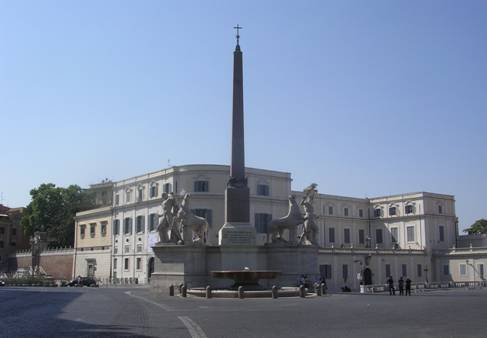
|
| Photo by Jeff Eaton |
| Piazza Quirinale |
| The Piazza sits atop the Quirinal Hill in front of the Presidential Palace |
| |
|
| |

|
| Photo by Jeff Eaton |
| Jaguar |
| This black Jaguar is quite indicative of the sort of people who do business atop the Quirinal Hill (and it's a beautiful car which everyone should have to opportunity to see). |
| |
|
| |
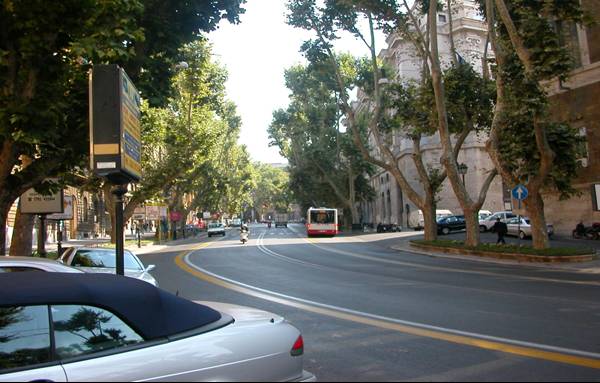
|
| Photo by Jeff Eaton |
| Via Veneto |
| Notice the wide, clean, green, and well-kept street of Via Veneto |
| |
|
| |
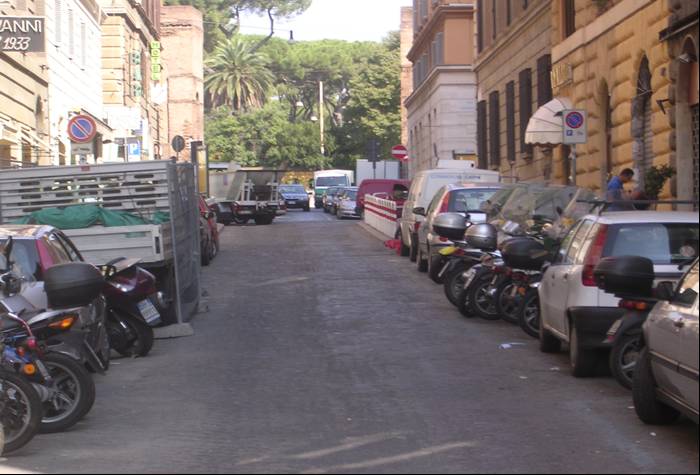
|
| Photo by Jeff Eaton |
| Residential Street |
| A standard, normally looking residential street; notice the contrast to Via Venteto only one block away. |
| |
|
| |
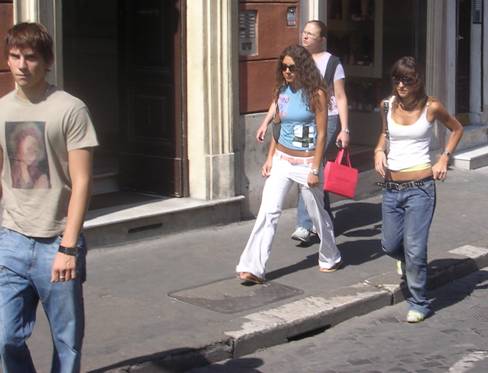
|
| Photo by Jeff Eaton |
| Trendy |
| Trendy Italian girls walk by the Spanish Steps |
| |
|
Quirinale Hill:
The defining feature of the Quirinale hill is the President’s Palace; it sets a political tone for the entire area. Most of the buildings hold government offices and consequently there is high security with many different types of police units. A vast majority of the buildings are built around a secluded courtyard, which keeps the streets relatively free of activity. The roads are kept very clean, and there is a considerable amount of construction under way to maintain all of the buildings. There is a lack of any graffiti and political posters. The area is filled mainly with people who work in the offices there and the streets are devoid of heavy pedestrian traffic.
One of the interesting notes of the area is that there are small parks that are open to the public.They are well-manicured, and elevated off of street level. Based on other experiences around the city, one can tell that these parks are unique to the Quirinale, with other regions having paved piazzae, but no green parks.
The overall sense that one gets from the area is that it is bourgeois, filled mainly with middle-aged government workers. While there was one church tucked in-between buildings, it was hardly noticeable. Overall the hill was completely secular and there are not any street shrines.
Via Veneto:
This upscale area was filled with high-priced hotels and restaurants. Buildings were floored with marble and the streets were lined with many different types of trees and also flowerbeds. It appeared that the area caters to mostly Americans as many posters, street signs, and restaurant menus are in English and restaurants offer an “American breakfast.” However, it is quite possible that some of the people staying in the upscale hotels were diplomats because many of the cars parked near hotels had dark-tinted windows and chauffeurs.
This section of the Quirinale was quite trendy, but it appeared to appeal to an older and wealthier tourist crowd with its fancy restaurants and upscale hotels. Still quite secular, the area was lacking in churches or any other symbols of religion.
Residential Quirinale:
The quiet roads and apartments in this section of the Quirinale immediately give the impression that this area is unique. While not as well maintained as other regions of the larger Quirinale area, such as Via Veneto and the Quirinale Hill, the buildings are still in good condition and there were people cleaning the streets.
There were quite a few churches in the area, however, they were very small and did not stand out. Rather, they seemed to blend into their surroundings due to their similar architecture as the rest of the buildings in the area.
Via Tritone:
In this area, while the presence of students was not noted, it was evident that the area catered, to a certain extent, to a student population. There were several bookstores selling academic texts, as well as music stores that featured concert posters for young and fashionable rock bands.
The area also seemed to be mixed with tourists, of many different nationalities. The street was lined many different types of shops that tourists would visit. Another prevalent population was the businessmen who seemed to just be passing through the area as they switched buses.
Spanish Steps:
The locale surrounding the Spanish Steps caters to a very chic and wealthy crowd. While there is a significant amount of traffic due to tourists sitting on the steps itself, the presence of well dressed Italians near the shops suggests that the area mainly serves a commercial purpose. Even the workers in the stores were very well dressed, and spoke good English, suggestive of the high level of sophistication in the entire area.
Filled mostly with designer name boutiques, there were not any signs of religion, such as street shrines, typically found in other small shopping areas around Rome. This secularity is generally characteristic of the entire Quirinale area.
Trevi Fountain Area:
The entire area surrounding the Trevi Fountain was saturated with all things tourist. Most of the people were gathered around the fountain or looking in shops, and came from several different countries, as was distinguishable from the spoken German, French, and Chinese heard. All of the street vendors and most of the shops sold mainly Rome memorabilia. Another interesting observation was that the Trevi Fountain area contained the highest proportion of immigrants, mainly Indian and African, and these people were mostly street vendors. However, although there weren’t any churches in the area, there a few street shrines that interested the tourists in the area. In keeping with the secular nature of the larger Quirinale area, religion did not appear to dominate anywhere.
|
| |
|
| |
|
| |
Further observations |
| |
| |

|
| Photo by Jeff Eaton |
| Polizia |
| Such forms of social control could be found throughout the neighborhood. |
| |
|
| |
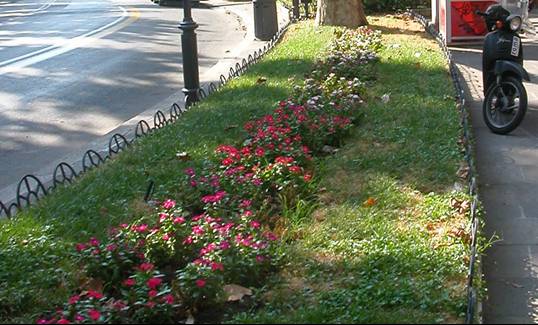
|
| Photo by Jeff Eaton |
| Flower Beds |
| The flower beds and other greenery along Via Veneto does wonders for the upscale feeling of the street. |
| |
|
What we found most unique and interesting is how Italians seem to have created an entire self-sufficient upper class community around the hill. The Quirinale has every aspect demanded of a complete neighborhood: residential, business, commercial, government, and a large tourist contingent. We were very impressed how the three main communities, business, governmental, and tourist, coexisted with each other frequenting similar areas without really mixing with each other. A good example of this is the commuters along Via Tritone or the coexistence of government and tourism in Via Veneto. The exceptions to this are the Spanish Steps, where the trendy designer stores are frequented both by tourists and Italians, and the Trevi Fountain where the local business survives on the patronage of tourists.
Close study of the Quirinale provides one with an excellent definition of the characteristics of an upper-class neighborhood. Most of the streets, even in the residential area, are wide and paved, with open and uncluttered sidewalks. Store fronts were not cramped and had elaborate displays. Restaurants had Americanized menus and extravagantly decorated tables. It can not be overstated how much the presence of trees throughout the area along the roads does for the ambience. Also, the high level of maintenance throughout Quirinale speaks to the wealth of the area- streets are kept remarkably clean, building facades are newly painted, and there is a notable lack of propaganda (posters, graffiti etc).
The streets are not polluted by smells or people and in fact, are noticeably lacking in both of these categories. This is evident of a high level of social control, as is the extremely high visibility of Polizia. Quirinale is a neighborhood that is closely monitored- the only people and objects in the streets are ones that are desirable to the inhabitants.
Finally, in coincidence with observations made in affluent neighborhoods of Naples and other cities, there is very little religious iconography throughout the Quirinale region. Any religious symbols that were present were Catholic, but it was all very subdued and blended with the surrounding architecture. It is clear that the prominence of politics and consumerism in the neighborhood leave little room for emphasis on religion but contrarily breed on overwhelming secularism in the area.
|
| |
|
| |
|
|
 |
|


















